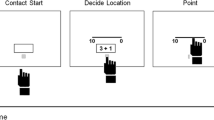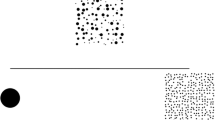Abstract
Recent evidence led to the conclusion that addition problems are biased towards overestimation, regardless of whether information is conveyed by symbolic or non-symbolic stimuli (the Operational Momentum effect). The present study focuses on the role of operands in the overestimation of addition problems. Based on the tie effect, and on recent evidence that the nature of operands biases addition problems towards an underestimation when operands are repeated, but towards an overestimation when different, we aim here to further elucidate the contribution of operands to addition problems. Experiment 1 replicates the underestimation of repeated-operand additions and overestimation of different-operand additions, with large numbers (around 50), and explores whether these effects also apply to small operand additions (around 10). Experiment 2 further explores the overestimation of different-operand additions by investigating the roles of operand order and numerical distance between operands. The results show that both factors have an impact on the overestimation size, but are not crucial for overestimation to occur. The results are discussed in terms of arithmetic strategies, spatial organization of numbers and magnitude representation.





Similar content being viewed by others
Notes
The term “small numbers”, as used in this literature, refers to magnitudes smaller than 5, and “large numbers” to numbers comprised between 5 and 9.
The main modification to the experimental manipulation in this study, in respect of that implemented by Charras et al. (2012), is in the use of three possible responses: inferior, equal and superior (instead of a two-alternative, forced-choice response of inferior/superior). This manipulation was aimed at slowing down responses, in order to avoid a speed-accuracy trade-off.
The distance “n” was removed from the statistical analysis.
As two participants failed to provide a single valid response in this specific condition, the degrees of freedom were changed from F(9, 261) to F(9, 243).
It should be noted that in this experimental manipulation, a distance of 4 units is considered as “close”. The contextual effects are so strong that, depending on the experiment design, the same condition can rely on different processes. Here, a 4-unit distance is considered as close, as compared to a 28-unit distance. To mimic the earlier statistical analyses reported herein, the n−4 and n+4 conditions were removed, and we computed the analyses with the O-Outcomes n−2 versus. n+2. Planned comparisons showed a significant effect for accuracy but not for RTs (F(1, 29) = 16.59, p < 0.001 for accuracy, but F < 1 for RTs).
Planned comparisons were also far from significance, when the n−4 and n+4 conditions (both Fs < 1) were eliminated.
References
Ashcraft, M. H. (1992). Cognitive arithmetic: A review of data and theory. Cognition, 44(1–2), 75–106.
Ashcraft, M. H. (1995). Cognitive psychology and simple arithmetic: A review and summary of new directions. Mathematical Cognition, 1, 3–34.
Ashcraft, M. H., & Christy, K. S. (1995). The frequency of arithmetic facts in elementary texts: Addition and multiplication in grades 1–6. Journal for Research in Mathematics Education, 26(5), 396–421.
Blankenberger, S. (2001). The arithmetic tie effect is mainly encoding-based. Cognition, 82, 15–24.
Butterworth, B., Zorzi, M., et al. (2001). Storage and retrieval of addition facts: The role of number comparison. Quarterly Journal Experimental Psychology, 54A, 1005–1029.
Campbell, J. I. D., & Graham, D. J. (1985). Mental multiplication skill: Structure, process, and acquisition. Canadian Journal of Psychology, 39, 338–366.
Campbell, J. I. D., & Gunter, R. (2002). Calculation, culture, and the repeated operand effect. Cognition, 86, 71–96.
Campbell, J. I. D., & Xue, Q. L. (2001). Cognitive arithmetic across cultures. Journal of Experimental Psychology: General, 130(2), 299–315.
Charras, P., & Lupiáñez, J. (2009). The relevance of symmetry in line length perception. Perception, 38(10), 1428–1438.
Charras, P., & Lupiáñez, J. (2010). Length Perception of Horizontal and Vertical Bisected Lines. Psychological Research, 74(2), 196–206.
Charras, P., Brod, G., & Lupiáñez, J. (2012). Is 26 + 26 smaller than 24 + 28? Estimating the approximate magnitude of repeated vs. different numbers. Attention Perception & Psychophysics, 74(1), 163–173.
Cordes, S., Gallistel, C. R., Gelman, R., & Latham, P. (2007). Nonverbal arithmetic in humans: Light from noise. Perception & Psychophysics, 69(7), 1185–1203.
Dehaene, S., Bossini, S., & Giraux, P. (1993). The mental representation of parity and numerical magnitude. Journal of Experimental Psychology: General, 122, 371–396.
Fischer, M. H. (2001). Number processing induces spatial performance biases. Neurology, 57(5), 822–826.
Fischer, M. H., Castel, A. D., Dodd, M. D., & Pratt, J. (2003). Perceiving numbers causes spatial shifts of attention. Nature Neuroscience, 6(6), 555–556.
Gallistel, C. R., & Gelman, R. (1992). Preverbal and verbal counting and computation. Cognition, 44(1–2), 43–74.
Gevers, W., Lammertyn, J., Notebaert, W., Verguts, T., & Fias, W. (2006). Automatic response activation of implicit spatial information: Evidence from the SNARC effect. Acta Psychologica, 122, 221–233.
Groen, G. J., & Parkman, J. M. (1972). A chronometric analysis of simple arithmetic. Psychological Review, 79, 329–343.
Knops, A., Viarouge, A., & Dehaene, S. (2009). Dynamic representations underlying symbolic and nonsymbolic calculation: Evidence from the operational momentum effect. Attention Perception & Psychophysics, 71(4), 803–821.
Lefevre, J. A., & Liu, J. (1997). The role of experience in numerical skill: Multiplication performance in adults from Canada and China. Mathematical Cognition, 3(1), 31–62.
LeFevre, J., Sadesky, G. S., & Bisanz, J. (1996). Selection of procedures in mental addition: Reassessing the problem size effect in adults. Journal of Experimental Psychology Learning Memory and Cognition, 22, 216–230.
Lefevre, J. A., Shanahan, T., & DeStefano, D. (2004). The tie effect in simple arithmetic: An access-based account. Memory & Cognition, 32(6), 1019–1031.
Lefevre, J. A., Smith-Chant, B. L., Hiscock, K., Daley, K. E., & Morris, J. (2003). Young adults’ strategic choices in simple arithmetic: Implications for the development of mathematical representations. In A. J. Baroody & A. Dowker (Eds.), The development of arithmetic concepts and skills: Constructing adaptive expertise (pp. 203–228). Mahwah, NJ: Erlbaum.
McCrink, K., Dehaene, S., & Dehaene-Lambertz, G. (2007). Moving along the number line: Operational momentum in nonsymbolic arithmetic. Perception and Psychophysics, 69(8), 1324–1333.
McCrink, K., & Wynn, K. (2009). Operational momentum in large-number addition and subtraction by 9-month-olds. Journal of Experimental Child Psychology, 103(4), 400–408.
Miller, K., Perlmutter, M., & Keating, D. (1984). Cognitive arithmetic: Comparison of operations. Journal of Experimental Psychology Learning Memory and Cognition, 10, 46–60.
Pinhas, M., & Fischer, M. H. (2008). Mental movements without magnitude? A study of spatial biases in symbolic arithmetic. Cognition, 109, 408–415.
Schneider, W., Eschman, A., & Zuccolotto, A. (2002). E-prime user’s guide. Pittsburg: Psychology Software Tools Inc.
Xu, Y. (2009). Distinctive neural mechanisms supporting visual object individuation and identification. Journal of Cognitive Neuroscience, 21(3), 511–518.
Xu, Y., & Chun, M. M. (2007). Visual grouping in human parietal cortex. Proceedings of the National Academy of Sciences, 104, 18766–18771.
Xu, Y., & Chun, M. M. (2009). Selecting and perceiving multiple visual objects. Trends in Cognitive Sciences, 13(4), 167–174.
Author information
Authors and Affiliations
Corresponding author
Rights and permissions
About this article
Cite this article
Charras, P., Molina, E. & Lupiáñez, J. Additions are biased by operands: evidence from repeated versus different operands. Psychological Research 78, 248–265 (2014). https://doi.org/10.1007/s00426-013-0491-y
Received:
Accepted:
Published:
Issue Date:
DOI: https://doi.org/10.1007/s00426-013-0491-y




